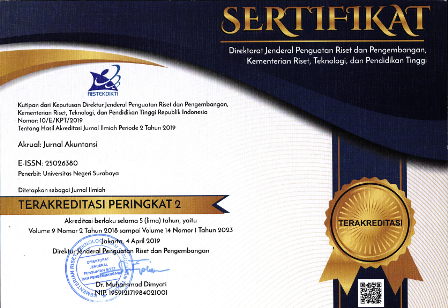What Are Leverage, Company Size, and Social Disclosure Considered to Reduce Market Response to Earnings Response Coefficient as an Intervening Variable?
DOI:
https://doi.org/10.26740/jaj.v15n2.p151-157Keywords:
leverage, company size, social disclosure, earnings response coefficientAbstract
Introduction/Main Objectives: This research examined the influence of leverage, company size and
social disclosure on the earnings response coefficient as an intervening variable. Background
Problems: Research showed that leverage ability, company size, and social disclosure influence the
earning response coefficient. Furthermore, the company size variable positively influenced ERC in
various industrial sector companies on the Indonesian Stock Exchange. Research Methods: This
type of research used quantitative methods. The research data was manufacturing companies that
were registered with an IPO before 2016 and were still listed on the IDX from 2016 to 2020. For
this reason, this regression model was suitable for testing and examining the effect of leverage on
the earning response coefficient. Finding/Results: The larger the company size increases the market
response because the company was considered capable of providing high returns. The social
disclosure variable does not influence ERC in various industrial sector companies on the Indonesian
Stock Exchange. Social disclosure was a principle or reaction carried out by companies to
participate in community activities in general. This practice causes the company's asset value and
profits low while the debt value and losses were high. Conclusion: High social disclosure was
considered to reduce market response. On the other hand, low social disclosure was deemed to
increase market response.
References
Adhariani. (2004). Extent of Voluntary Disclosure in Annual Reports and Its Relationship with Current Earnings Response Coefficient (ERC). Indonesian Journal of Accounting and Finance. Vol 2, No. 1: 24-57.
Anggraini, Fr. R. R, (2006). Disclosure of Social Information and Factors that Influence Disclosure of Social Information in Annual Financial Reports. IX National Accounting Symposium. Padang.
Ardianto, B. S. (2013). The Influence of Profitability, Leverage, Size and Growth on Profit Management in Manufacturing Companies Listed on the Indonesian Stock Exchange 2007-2010. Undergraduate Thesis, Christian University Discourse Ambassador.
Arikunto, S. 2006. Research Procedures, a Practical Approach. Jakarta: Rineka Cipta.
Belkoui, Riahi. (2000). Accounting Theory. Volume One. Accounting Theory. Fourth Edition. Salemba Four. Jakarta.
Beaver W.H. (1968). "The Information Content of Annual Earnings Announcements". Journal of Accounting Research. Supplements. Pp. 67-49
Bringham, F. H. & Joel F. H. (2001) Financial Management. Eighth edition, Jakarta. Erlangga.
Cho, J. Y & K. Jung. (1991). Earnings Response Coefficient: A Synthesis of Theory and Empirical Evidence. Journal of Accounting Literature. 10: 85-116.
Collins. D. W. & S. P. Kothari. (1989). "An Analysis of Intemporal and Cross Sectional Determinants of Earnings Response Coefficient". Journal of Accounting and Economics. 11: 143-182.
Dhaliwal, D. S. & Farger. N. L. (1991). "The Association Between Unexpected Earnings and Abnormal Security Returns in the Presence of Financial Leverage". Contemporary Accounting Research. 8: 20-41.
Easton, P. D. & Zmijweski. M. E. (1989). "Cross-Sectional Variation in the Stock Market Response to Accounting Earnings Announcements". Journal of Accounting and Economics (July): 117-141.
Fitriani. (2001) Significance of Differences in the Level of Completeness of Mandatory and Voluntary Disclosures in the Financial Reports of Public Companies Listed on the Jakarta Stock Exchange. IV National Accounting Symposium Paper, Bandung. Padjadjaran University and the Indonesian Accountants Association pp.133-154.
Ginting, Cecilia Y. (2008). Analysis of the Extensive Influence of Social Disclosure in Company Annual Reports on Investor Reactions and Company Performance in Manufacturing Companies Listed on the Indonesian Stock Exchange. FE USAKTI. Jakarta.
Ghozali, I. 2018. Application of Multivariate Analysis with the SPSS Program. Semarang: Diponegoro University Publishing Agency.
Haniffa R.M. & Cooke T.E. (2005). The Impact of Culture and Governance on Corporate Social Reporting. Journal of Accounting and Public Policy 24: 391-430.
Husiano, D. & Suratno. (2014). Analysis of the Effect of Beta, Leverage, Dividend Payout Ratio, and Earning Persistence on the Earning Response Coefficient on the Kompas 100 Index. Journal of Accounting and Taxation Research, JRAP 1(2), 121-135.
Indonesian Accounting Association. (2004). Statement of Financial Accounting Standards, Jakarta: Salemba Empat Publishers.
Meckling. J. (1976) The Agency Theory of the Firm: Managerial Behavior, Agency Costs and Ownership Structure Journal of Financial Economics 3 : 305-360.
Kristanti, K.D. & Almilia, L.S. (2019). Factors Affecting Earnings Response Coefficient (ERC) in Manufacturing Companies Listed on BEI. The Indonesian Journal of Accounting Research, 22(2), 153-178.
Kuncoro, M. (2004). Quantitative Methods: Theory and Applications to Business and Economics. Second Edition. Yogyakarta: AMP YKPN Publishing and Printing Unit.
Lev. (1989). On Usefulness of Earnings: Lessons Ans Directions from Two Decades of Empirical Research. Journal of Accounting Research 27 (supplement) pp. 153-192.
Lev. B.P & Zarowin. (1999). The Boundaries of Financial Reporting and How to Extend Therm. Journal of Accounting Research, 31, Autumn. Pp. 246-271
Manwata. (2000) The Relationship between Company Characteristics and the Quality of Voluntary Expressions in Annual Reports of Companies in Indonesia. Master's Thesis, Gadjah Mada University Yogyakarta.
Meek. R and Gray (1955). Analysis of the Influence of Company Fundamental Factors on the Completeness of Financial Reports. Accounting journal.
Mulyani. S. (2017). Factors that Influence the Earnings Response Coefficient of Companies listed on the Jakarta Stock Exchange. JAAI. 11(1):35-45.
Murwaningsari. E, (2008). Simultaneous Testing: Several Factors Affecting Earnings Response Coefficient (ERC). Accessed 20 December 2015.
Riduwan & Kuncoro, E. A. 2012. How to Use and Interpret Path Analysis (Path Analysis) (B. Alma, Ed.). Fourth Printing. Bandung: Alphabeta
Riyanto. B. (1995) Basics of Corporate Spending. Fourth edition, first printing.Yogyakarta.BPFE.
Rosiyana. D. S. (2009). Analysis of the Influence of Company Characteristics on ERC with CSR as an Intervening Variable in Manufacturing Companies listed on the IDX. Faculty of Economics, Trisakti University, Jakarta. Accessed December 20, 2015.
Sayekti. Y & Wondabio L. S. (2007) The Effect of CSR Disclosure on Earnings Response Coefficient. IX National Symposium.
Silalahi P. (2014). The Influence of Corporate Social Responsibility (CSR) Disclosure, Beta and Price to Book Value (PBV) on Earnings Response Coefficient (ERC) (Empirical Study of Manufacturing Companies Listed on the Indonesian Stock Exchange). Department of Accounting, Faculty of Economics, Riau University. Economic Journal Volume 22, Number 1 March 2014.
Scott, W. R. (2015). Financial Accounting Theory. 2nd ed. Canada: Prentice Hall Inc. Ontario.
Sudana, I. M. (2011). Corporate Financial Management. Jakarta: Erlangga Publishers.
Suripto. B. (1999) The Firm Characteristic Effect to Extent of Voluntary Disclosure in the Annual Report. National Accounting Symposium, II: 1-17.
Untari, M.D. & Budiasih, I.G.A.N. (2014). The Influence of Earnings Conservatism and Voluntary Disclosure on Earnings Response Coefficient. Udayana Accounting Journal, 7(1), 1-18.
Watts, R. (1978). "Systematic Abnormal Return After Quarterly Earnings Announcement". Journal of Financial Economics No. 6.
Watts, R. L. & Zimmerman J. L. (1986). Positive Accounting Theory. New Jersey: Prentice Hall.
Wijayanti, R. D.P. (2013). Leverage and Firm Size on Response Coefficient (Erc) with Voluntary Disclosure as an Intervening Variable. STIE Widya Gama Lumajang. Volume 2, Number 2, August 2013.
Zubaidi, & Zahron. (2011). Analysis of Factors Affecting Earnings Response Coefficient (Erc): Study of Property and Real Estate Companies Listed on the Indonesian Stock Exchange.
Downloads
Published
How to Cite
Issue
Section
License
Copyright (c) 2024 Abd Rohman Taufiq Taufiq

This work is licensed under a Creative Commons Attribution-NonCommercial 4.0 International License.
 Abstract views: 501
,
Abstract views: 501
, PDF Downloads: 393
PDF Downloads: 393

















